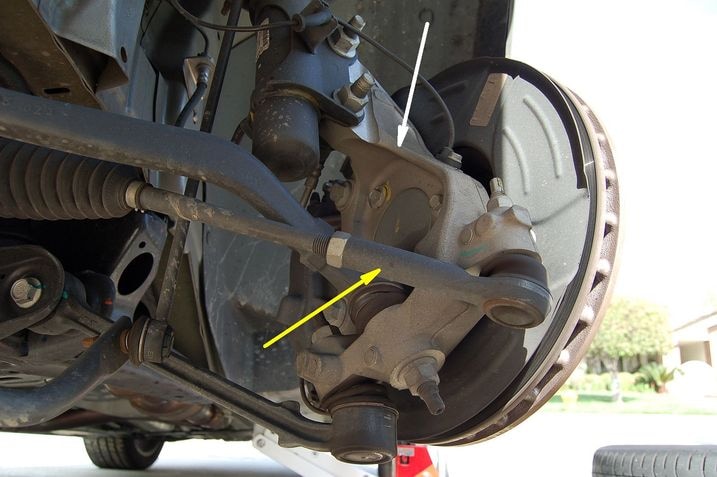
I'm tired of unintended acceleration. I want to get back to talking about acceleration that is fully intended (and appreciated) and the cars that are built to manage it well. What better way to take the automotive equivalent of a Silkwood Shower than a suspension walkaround of our 2010 Chevrolet Camaro SS?
Let's get right to it, shall we?

Up front, there's a coil-over MacPherson strut.

But the lower end does not have the single L-shaped lower arm that most strut suspensions have. Instead, there are two lower links (white), each with its own ball joint, just like the closely-related Pontiac G8 GT.
The front stabilizer bar (green) connects to the strut body via a long, slender link (yellow) for a 1:1 motion ratio.

Like most cars with north-south engines and rear-wheel drive, the Camaro's steering arm (yellow) acts ahead of the axle centerline. The hub carrier it attaches to (white) is aluminum, unlike the Pontiac G8, which uses one made of steel.

Here's a closer look at the dual lower links and their ball joints. The forward one (yellow) comes in from above so that the steering arm can sneak past underneath.

Them's some big brakes - much bigger than the 2-piston sliding calipers found on the front of our dearly departed G8 GT. These calipers (green) are 4-piston fixed units from Brembo. A clump of mass-damping weights (white) have been unceremoniously stuck to them (where they don't show much), presumably to quell a resonant vibration. The ventilated rotors (yellow) are 1-piece cast units.

Out back, the rear multi-link suspension looks very, very similar to that found in the G8 GT. Like the Pontiac, "multi" in this case means three links and one L-shaped upper arm.
Two links (green forward, red aft, behind the shock) make up what amounts to a lower wishbone. The fully boxed upper arm (white) curves off behind the shock to meet its hidden second pivot. A toe-link (yellow) keeps the wheel pointed in the right direction.

Here's a snail's-eye view of the lower links and their wishbonesque arrangement.

Left to right (and bottom to top): forward lower link (yellow); toe link (green); and upper arm (white). The forward upper pivot of the upper arm, a pillow ball, is just barely visible. The rear pivot is a higher volume rubber bushing that's hidden off behind the spring and shock.

The rear lower link does quite a bit of work as the spring/shock assembly and the stabilizer bar connect to it. The shape is slightly different from that of the G8 GT, but it's very close. The stab bar motion ratio looks about the same(0.4:1), but the spring/shock motion ratio looks a little smaller (0.7:1).

Like the front, the Camaro's rear knuckles (yellow) are made of aluminum. Those of the Pontiac G8 GT are steel. They also house ginormous 4-piston fixed Brembo calipers of an open design for easy pad swaps and an external crossover tube (black) to send fluid to the outer pair of pistons.

That'll do.

Front tires: 245/45ZR20 (103Y), weighing in at 63.0 pounds
Rear tires: 275/40ZR20 (106Y), weighing in at 67.5 pounds.
If you care to compare to the Pontiac G8 GT walkaround, go here. You'll see the major differences, but many important departures from the G8 are invisible to the naked eye: the spring rates, the internal valving of the struts and shocks, bushing hardness and a host of others. Such suspension tuning differences are not to be underestimated.
Dan Edmunds, Director of Vehicle Testing @ 16,487 miles (or is it 14,867?)
